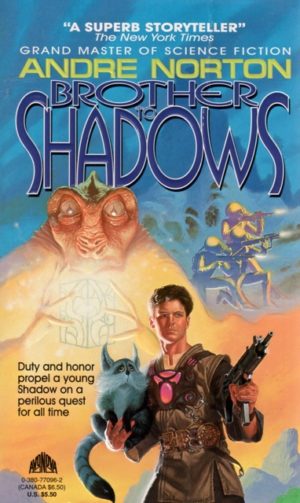According to the cover copy, Brother to Shadows (1993) was Andre Norton’s return to science fiction after a decade of writing in other genres. From the vantage of 2021 and an ongoing project of reading and rereading her entire catalogue, all I can say is, she certainly profited from the time away. This is a work of great confidence, skillful and assured, with frequent references to older works. It reads as if she had processed everything she knew, given herself a break from this particular set of tropes, and come back fresh and stronger than ever.
It was the perfect book to read during a more than usually difficult week, at the start of year two (ye gods) of the pandemic that will not end. It’s grand escapism, full of favorite themes and character types. It’s just plain fun.
It starts off rather like one of her fantasy novels, with a ninja-like order of warriors and priests, but quickly reveals that it’s grounded in one of her best-loved science-fiction universes, the one with Forerunners and Free Traders and the wicked Thieves’ Guild and the good old Solar Queen. We don’t actually meet that last, but there’s a shout-out to warm the heart of a devoted fan. The action begins on a backwater world, throwing us straight into the collapse of a Lair of Shadow-Brothers and the expulsion of one young Brother. Jofre is the classic Norton orphaned misfit, a foundling from offworld, rescued from a lifeboat crash and raised in the order. He’s talented, maybe too much so; he suffers the envy and spite of the Lair’s Shagga priest, who casts him out into the winter wilderness to die.
Buy the Book


A Psalm for the Wild-Built
But Jofre is talented and has a fair share of luck. He makes his way to the spaceport through another, much older fallen Lair, where he picks up another classic Norton trope, a mysterious stone of unknown but considerable power. Like many a Norton protagonist before him, he doesn’t know why, but he is compelled to hide the stone from everyone, even those he comes to trust.
There’s a complicated swirl of plots and subplots around him. Certain forces in the Brotherhood want him dead, but also want to find out what he took from the ruined Lair. The Thieves’ Guild is meddling on multiple fronts, especially after Jofre rescues an offworlder from a near-fatal mugging.
Jofre’s heroism gains him a patron in the best tradition of the Brotherhood. This is a member of my all-time favorite Norton alien species, one of the gentle, scholarly, long-lived lizard people, the Zacathans. Zurzal is quite young for one of his people, and somewhat discredited among them for his obsession with a Forerunner artifact that he has reconditioned and wants to try out on another backwater world. This artifact supposedly allows its user to see through time and view specific events in the past.
This device, both the literal machine and the device of time travel as a virtual experience, is not new to the Norton canon. I was reminded particularly here of an earlier entry in this universe, Forerunner Foray, in many of its themes and some of its characters.
In this particular iteration, Zurzal is a true Zacathan. He isn’t interested in monetizing his discovery. He just wants to learn about the time of the Forerunners. Others are not so high-minded. One such group abducts him and his now bodyguard, Jofre, and hauls them off to yet another backwater planet, where they’re embroiled in local political upheavals.
Meanwhile the Guild is after Jofre, and commands another one of his order, the Jewelbright or courtesan/assassin Taynad, to keep track of Jofre and eventually kill him. But Taynad has a mind of her own, and she comes to share it with yet another classic Norton character, a mysterious furry alien. Yan is telepathic, and his species will bond with a single human and serve as a combination guard and communications device.
Jofre also becomes part of this psychic bond. The three of them gravitate toward and away from one another as the action races from planet to ship to planet again, but they can never completely be separated once the bond has formed. Between that and Jofre’s oathbinding to the Zacathan, the web of obligation is complex and sometimes contradictory, forcing them all to make difficult or impossible choices.
At first I was quite salty about Taynad. A courtesan? Really? How retro. But then a female rebel leader spoke my thoughts, and I realized that Norton was having some fun. Taynad is a great deal more than an off-the-rack space-opera Sexy Female, even beyond her ninja capabilities. She makes her own choices, orients her own moral compass, and submits to no one, except as part of her cover. This is how to do the trope, Norton seems to be saying. In 1993, that was by no means new or unique, but it was a departure from what tended to be the norm.
As I said, this is a lot of fun. It’s got breakneck action, exciting adventure, time travel of a sort, political machinations (and a revolution to spice it up), crime syndicates, Patrol officers both good and bad and for the most part somewhere in the middle, evil priests, a wide array of aliens, and plenty of good old-fashioned martial arts, both physical and psychic. It’s well aware of its strengths in plotting and worldbuilding. It’s very much the work of a mature writer who knows her craft and is comfortable returning to an old and familiar universe.
In short: It’s perfect for these times we live in.
Next time I’ll be rereading a title I remember fondly, though it’s been a long time since I last looked at it: Garan the Eternal.
Judith Tarr’s first novel, The Isle of Glass, appeared in 1985. Since then she’s written novels and shorter works of historical fiction and historical fantasy and epic fantasy and space opera and contemporary fantasy, many of which have been reborn as ebooks. She has even written a primer for writers: Writing Horses: The Fine Art of Getting It Right. She has won the Crawford Award, and been a finalist for the World Fantasy Award and the Locus Award. She lives in Arizona with an assortment of cats, a blue-eyed dog, and a herd of Lipizzan horses.










